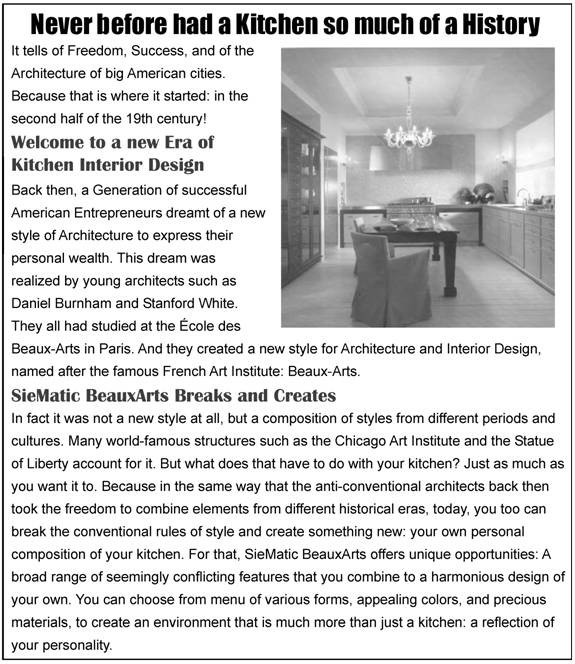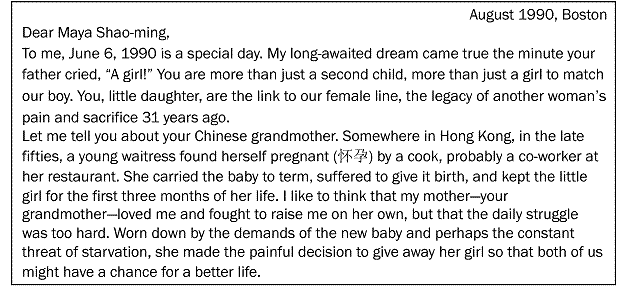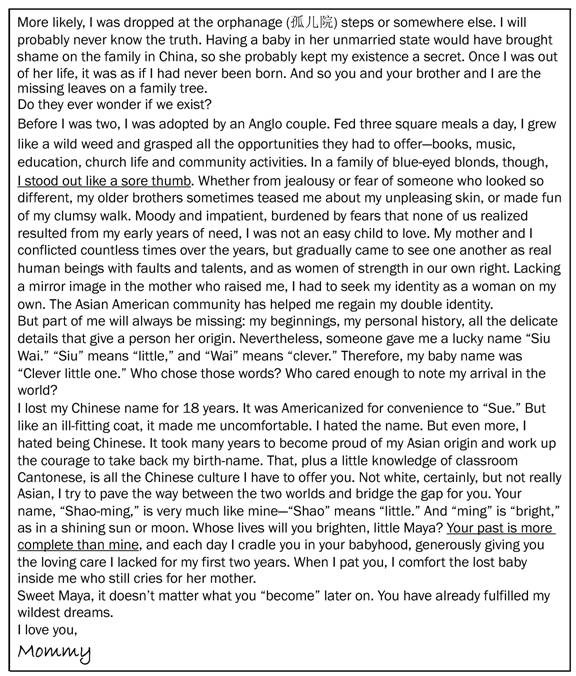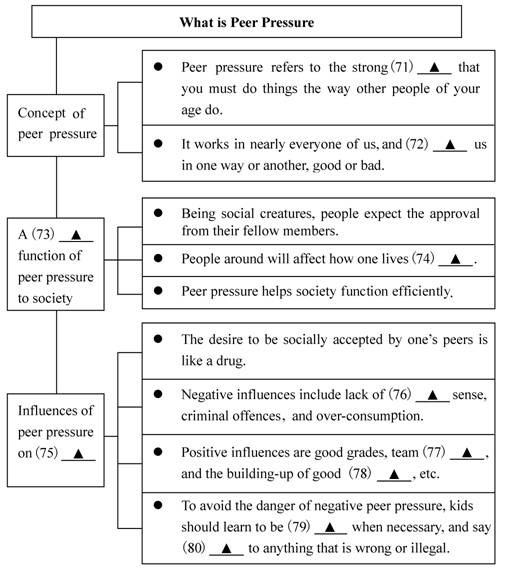第三部分: 阅读理解 (共 15 小题; 每小题 2 分, 满分 30 分)
请阅读下列短文, 从短文后各题所给的 A、B、C、D 四个选项中, 选出最佳选项, 并在答题卡上将该项涂黑。
A

56. Why did the BeauxArts style attract American entrepreneurs?
A. It helped display their money status. B. It was created by famous architects.
C. It was named after a famous institute. D. It represented the 19th century urban culture.
57. What is unique of SieMatic BeauxArts?
A. Its designs are anti-conventional.
B. Its designs come from famous structures.
C. Its customers can enjoy their own composition.
D. Its customers can choose from various new styles.
B
However wealthy we may be, we can never find enough hours in the day to do everything we want. Economics deals with this problem through the concept of opportunity cost, which simply refers to whether someone’s time or money could be better spent on something else.
Every hour of our time has a value. For every hour we work at one job we could quite easily be doing another, or be sleeping or watching a film. Each of these options has a different opportunity cost—namely, what they cost us in missed opportunities.
Say you intend to watch a football match but the tickets are expensive and it will take you a couple of hours to get to and from the stadium. Why not, you might reason, watch the game from home and use the leftover money and time to have dinner with friends? This—the alternative use of your cash and time—is the opportunity cost.
For economists, every decision is made by knowledge of what one must forgo—in terms of money and enjoyment—in order to take it up. By knowing precisely what you are receiving and what you are missing out on, you ought to be able to make better-informed, more reasonable decisions. Consider that most famous economic rule of all: there’s no such thing as a free lunch. Even if someone offers to take you out to lunch for free, the time you will spend in the restaurant still costs you something in terms of forgone opportunities.
Some people find the idea of opportunity cost extremely discouraging: imagine spending your entire life calculating whether your time would be better spent elsewhere doing something more profitable or enjoyable. Yet, in a sense it’s human nature to do precisely that—we assess the advantages and disadvantages of decisions all the time.
In the business world, a popular phrase is “value for money.” People want their cash to go as far as possible. However, another is fast obtaining an advantage: “value for time.” The biggest restriction on our resources is the number of hours we can devote to something, so we look to maximize the return we get on our investment of time. By reading this passage you are giving over a bit of your time which could be spent doing other activities, such as sleeping and eating. In return, however, this passage will help you to think like an economist, closely considering the opportunity cost of each of your decisions.
58. According to the passage, the concept of “opportunity cost” is applied to ________.
A. making more money B. taking more opportunities
C. reducing missed opportunities D. weighing the choice of opportunities
59. The “leftover ... time” in Paragraph 3 probably refers to the time ________.
A. spared for watching the match at home B. taken to have dinner with friends
C. spent on the way to and from the match D. saved from not going to watch the match
60. What are forgone opportunities?
A. Opportunities you forget in decision-making.
B. Opportunities you give up for better ones.
C. Opportunities you miss accidentally.
D. Opportunities you make up for.
C
Most damagingly, anger weakens a person’s ability to think clearly and keep control over his behaviour. The angry person loses objectivity in evaluating the emotional significance of the person or situation that arouses his anger.
Not everyone experiences anger in the same way; what angers one person may amuse another. The specific expression of anger also differs from person to person based on biological and cultural forces. In contemporary culture, physical expressions of anger are generally considered too socially harmful to be tolerated. We no longer regard duels (决斗) as an appropriate expression of anger resulting from one person’s awareness of insulting behaviour on the part of another.
Anger can be identified in the brain, where the electrical activity changes. Under most conditions EEG (脑电图) measures of electrical activity show balanced activity between the right and left prefrontal (额叶前部) areas. Behaviourally this corresponds to the general even-handed disposition (意向) that most of us possess most of the time. But when we are angry the EEG of the right and left prefrontal areas aren’t balanced and, as a result of this, we’re likely to react. And our behavioural response to anger is different from our response to other emotions, whether positive or negative.
Most positive emotions are associated with approach behaviour: we move closer to people we like. Most negative emotions, in contrast, are associated with avoidance behaviour: we move away from people and things that we dislike or that make us anxious. But anger is an exception to this pattern. The angrier we are, the more likely we are to move towards the object of our anger. This corresponds to what psychologists refer to as of ensive anger: the angry person moves closer in order to influence and control the person or situation causing his anger. This approach-and-confront behaviour is accompanied by a leftward prefrontal asymmetry (不对称) of EEG activity. Interestingly, this asymmetry lessens if the angry person can experience empathy (同感) towards the individual who is bringing forth the angry response. In defensive anger, in contrast, the EEG asymmetry is directed to the right and the angry person feels helpless in the face of the anger-inspiring situation.
61. The “duels” example in Paragraph 2 proves that the expression of anger ________.
A. usually has a biological basis B. varies among people
C. is socially and culturally shaped D. influences one’s thinking and evaluation
62. What changes can be found in an angry brain?
A. Balanced electrical activity can be spotted.
B. Unbalanced patterns are found in prefrontal areas.
C. Electrical activity corresponds to one’s behaviour.
D. Electrical activity agrees with one’s disposition.
63. Which of the following is typical of offensive anger?
A. Approaching the source of anger. B. Trying to control what is disliked.
C. Moving away from what is disliked. D. Feeling helpless in the face of anger.
64. What is the key message of the last paragraph?
A. How anger differs from other emotions. B. How anger relates to other emotions.
C. Behavioural responses to anger. D. Behavioural patterns of anger.
D


65. Why is June 6, 1990 a special day for Mommy?
A. Her dream of being a mother came true.
B. She found her origin from her Chinese mother.
C. She wrote the letter to her daughter.
D. Her female line was well linked.
66. How does Mommy feel about her being given away?
A. It is bitter and disappointing.
B. It is painful but understandable.
C. She feels sorry but sympathetic.
D. She feels hurt and angry.
67. What does “I stood out like a sore thumb” in Paragraph 5 mean?
A. I walked clumsily out of pains.
B. I was not easy to love due to jealousy.
C. I was impatient out of fear.
D. I looked different from others.
68. What can be inferred from Mommy’s Anglo family life?
A. She used to experience an identity crisis.
B. She fought against her American identity.
C. She forgot the pains of her early years.
D. She kept her love for Asia from childhood.
69. Why did Mommy name her daughter “Shao-ming?”
A. To match her own birth-name.
B. To brighten the lives of the family.
C. To identify her with Chinese origin.
D. To justify her pride in Chinese culture.
70. By “Your past is more complete than mine,” Mommy means ________.
A. her past was completed earlier than Shao-ming’s
B. Shao-ming has got motherly care and a sense of roots
C. her mother didn’t comfort her the way she did Shao-ming
D. her past was spent brokenly, first in Asia, then in the US



